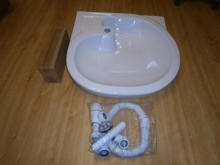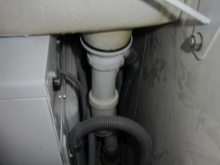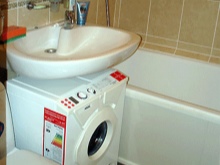Sink jug for placing over the washing machine
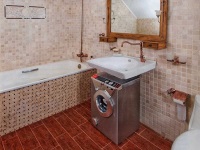
Every year on the plumbing market there are hundreds of solutions for the bathroom, designed to make our lives more convenient. The sink, which is installed above the washing machine, has not been a novelty for a long time, but its advantages have been truly appreciated only now. Today more and more people are thinking about organizing the space in the bathroom in a new way, to make the room more ergonomic. And this means that it is time to get rid of the old, non-functional and bulky sanitary ware and look at more modern and elegant models.
The jug basin is an example of how you can rationally use space in the bathroom. This design is just created for small bathrooms, which in our houses are the majority. Even in the smallest bathroom you can find a place to install such a sink, thereby relieving the kitchen area from the clutter of unnecessary appliances.
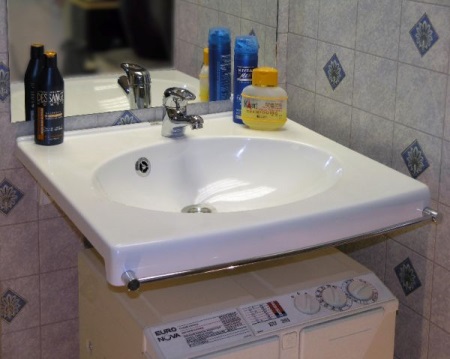
Pros
- The main advantage of the jug basin is that with its help you can free up space in the bathroom that would be occupied by washing machine. The space thus freed up can be used to install other sanitary equipment or furniture, such as a bidet, a small shower stall or a cabinet for toiletries.
- The sink above the washing machine still looks quite original. If you choose equipment that is harmoniously matched in color and style, such a design will be perceived primarily as an unusual design solution, rather than as a forced measure in order to save space.
- The choice of sink pots is very diverse. They vary in functionality, shape, size and materials of production. Therefore, you will definitely be able to find the sink that will perfectly fit exactly in your bathroom.
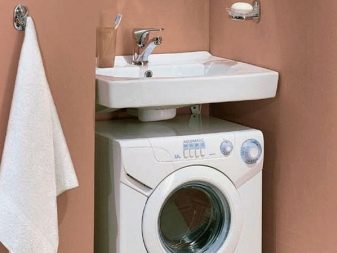
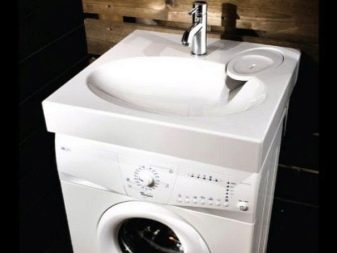
Disadvantages .
- Those who are already the owner of the sink-pot, note the inconvenience associated with the inability to come close to the washbasin. For many people this causes quite a lot of discomfort when performing daily hygiene procedures.
- If the user still manages to get close enough to the sink, it may happen that he accidentally touches the controls of the washing machine with his feet or belly. If the machine is turned off in this case, then nothing terrible will happen. But pressing the buttons on a running "washing machine" can cause unpleasant consequences.
- If the dimensions of the sink and washing machine are not properly sized, then there is a risk of water splashing on the "washing machine" and on the electrical outlet, which can lead to serious problems.
- Not every washing machine can be installed under the sink pitcher. Only small-sized models are suitable for this purpose, which not all manufacturers produce.
- A special flat siphon is needed for the jug basin. If one does not come with the washbasin, then you will have to buy it yourself, and the search may take some time. In addition, the horizontal drain requires increased attention to itself, as it quite often forms clogs.
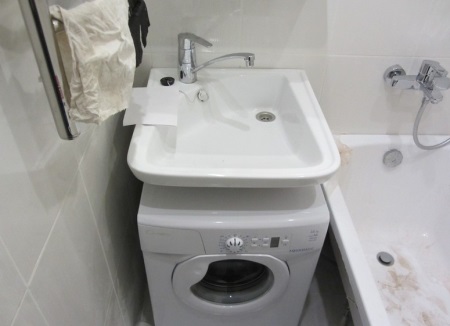
Features
- Sinks for installation under the washing machine come with two types of drain hole. The first type drain is located directly above the washing machine and is considered a fire hazard. The second type in terms of fire safety is preferable: it is located behind the washing machine.
- Since pitcher sinks are made for washing machines, they have a non-standard shape. The bottom of such models is wide and flat - so much so that a fairly large unit can fit under it.
- In sanitary stores, models of sinks-pitchers without a hole designed for a faucet prevail. This is due to the fact that in the lack of space is much more reasonable to install a common faucet for the bath and washbasin or install a faucet in the wall above the sink.
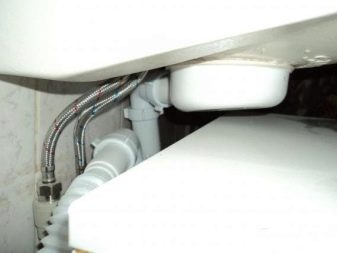
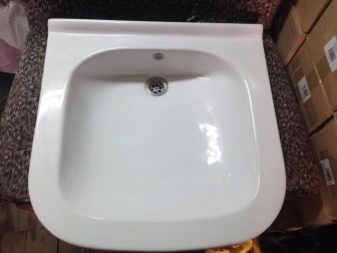
Popular sizes and models
- "Quattro" - a square-shaped sink with a size of 60x60 cm. It is made of faience with an enamel coating that is resistant to abrasion. The drain is moved to the side of the wall and the hole for the faucet is in the center.
- "Uni-50", "Uni-60" - standard sinks with rounded corners, have dimensions 60x60 cm and 60x50 cm respectively. The material is enameled faience. The hole for the faucet is in the center, and the drain is as close to it as possible. There is an overflow.
- "Victoria" is a compact sink measuring 60.5x59.5 cm. A distinctive feature is the location of the hole for the mixer tap - it can be installed in the left or right corner of the sink. This comes with a soap dish made of earthenware.
- "Light" is a flat sink with the size of 61x60 cm. This model does not have a hole for the faucet. The drain is shifted as close to the wall as possible, so you can get all the communications behind the washing machine.
- "Elegance" is a simple model for small washing machines. Its dimensions are 62x60 cm. There is no hole to install a mixer. Drainage hole is shifted to the side of the wall.
- "Lux Lite" - the sink of standard height 62x60 cm. It is equipped with a hole for a mixer and an overflow. Drainage hole is located near the mixer, which provides the convenience of bringing communications.
- "Dial is a rather large model measuring 63.5x57 cm. You can install the tap in the left or right corner of the sink, and the faience soap dish is placed in the opposite corner. The drain hole is moved as close to the faucet as possible.
- "Bolero" is a beautiful round sink that can be installed in the corner of the bathroom. Its dimensions are 60x64 cm. The hole for the faucet is located in the left corner, next to it there is a drain.
- "Mini" is a miniature sink for the smallest washing machines. The dimensions are 64x50 cm. The standard rectangular shape allows you to install this model anywhere in the bathroom. There is a hole for the faucet and overflow.

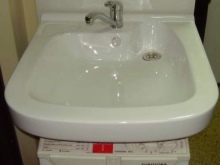
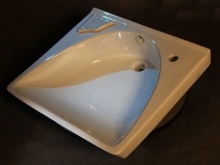
Features of choice
Choosing a sink, which will be installed above the washing machine, you need to follow a few simple rules, and then the resulting design will be convenient and safe to use:
- The sink-pot should necessarily be wider and deeper than the washing machine. The difference should be not less than 2 cm, and it is better if the indentation is 5 cm.
- Despite the fact that the horizontal drain is prone to the formation of clogs, it is preferable to choose a "jug" with this type of drain. It is more advantageous to carry out regular preventive maintenance of clogs than to repair a flooded washing machine or change the wiring.
- If possible, buy a model with a drainage hole. This way you can protect your and your neighbor's property from flooding.
- You should also take into account the presence / absence of a hole for the mixer. Here there are no strict recommendations, it all depends on your individual preferences.
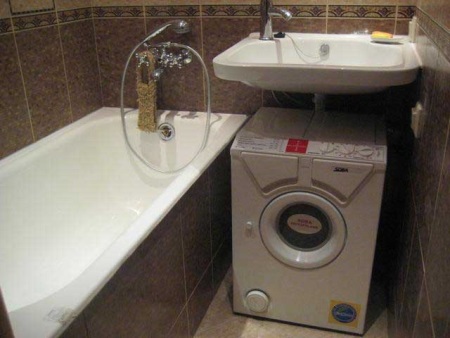
What kind of washing machine is suitable?
As we have already said, not all models of washing machines can be used for installation under the sink. You need them to meet two basic requirements:
- So that during washing and hand washing there is as little inconvenience as possible, the height of the washing machine should not exceed 70 cm.
- The depth of the washing machine is no less important factor. The smaller it is, the more comfortable the jug sink will be in use. Depending on the size of the sink, you should choose a machine with a depth of 34 to 43 cm.
Do not think that finding a washing machine that will meet these requirements and, at the same time, successfully cope with the task of washing will be difficult. Manufacturers of household appliances have long ago learned to make modern compact models with a sufficiently large tank volume.
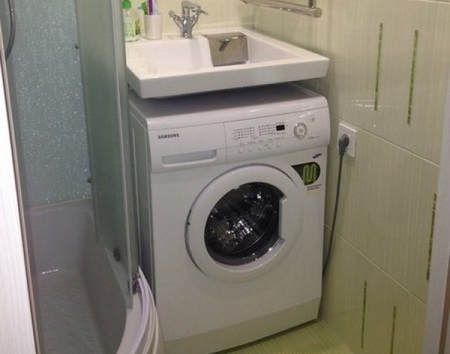
Installation rules
Installation of the sink-pot is made in the following order:
- The sink is tried on the place of installation and draw a marking on the wall.
- Drill holes in the wall.
- With the help of bolts fix the brackets (when fixing screws leave a gap of 5 mm).
- Sink jug set on the brackets, aligning horizontally.
- Assemble the drain siphon and connect it to the drainage hole.
- The washing machine drain hose is connected to a special siphon outlet.
- The connection is sealed with a clamp.
- Connect the corrugated pipe with a sewage pipe.
- Using a metal hook, sold with the sink, mount the device to the wall.
- The fasteners are tightened with a self-tapping screw and dowel.
- The bolts are screwed all the way in.
- The back part of the sink is covered with a sealing compound.
